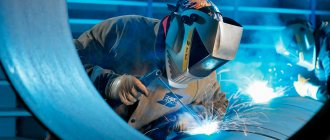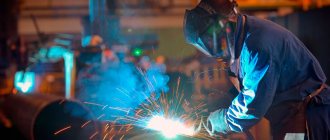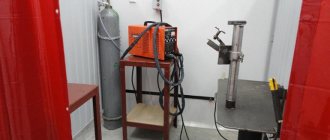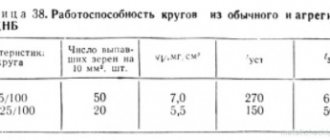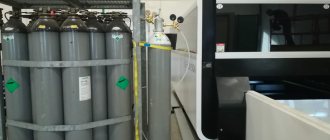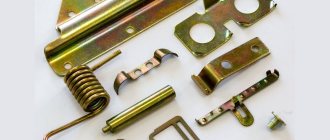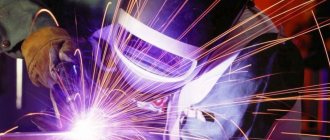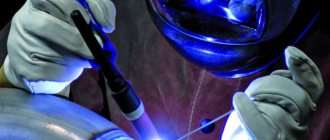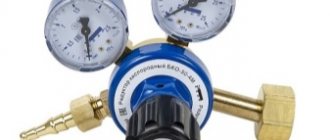The welding process involves high temperatures, open flames, and flammable gases. To avoid injury and loss of property from fires, it is necessary to adhere to fire safety rules when welding.
The risk of fires increases in confined spaces where it is difficult to move equipment around. Not everywhere there is a fire alarm, so it is useful to know what to do if a fire does occur during welding, which is important to have on hand in case of an emergency.
Fire safety during welding work is regulated by law. SNiPs and rules have been developed that not only professionals, but also novice welders must follow. Fire safety measures when carrying out welding work will help preserve your health and protect you from financial losses.
Possible hazards when performing hot welding work
All types of welding pose a fire hazard. Electric arc fire is especially dangerous - hot sparks fly over long distances. They are capable of igniting flammable materials at a distance of up to five meters. In a garage or workshop, when performing welding work, fires of oily rags, rags, and dry garbage cannot be ruled out. When welding with an open arc, flammable liquids and gases are at risk.
Strong splashing of hot metal, over a distance of up to a meter, is possible when welding in a carbon dioxide environment. Resistance welding, electroslag welding, is less dangerous. But under the influence of current, it is possible that the wiring may catch fire if there are insulation defects. The core heats up to the ignition temperature of paper, plastic, wood. The risk of fires increases if a thick wire is used instead of a secondary winding, equipment is connected incorrectly, or there is no grounding phase.
Gas welding technology uses an open flame; flammable gas is contained in acetylene cylinders, which are explosive. A working burner is a source of increased danger. One wrong move and a fire is possible if there are flammable surfaces or materials nearby. It’s not for nothing that only trained people are allowed to do hot work. They are subject to strict requirements and are held liable for damage to property in the event of a fire.
OCCUPATIONAL SAFETY REQUIREMENTS IN EMERGENCIES
4.1. If a fire is detected during work, you must immediately notify your immediate supervisor and call the fire department by calling 101 or 112. Before the fire department arrives, you must take measures to evacuate people and property and begin extinguishing the fire. 4.2. In the event of a malfunction of the welding unit, welding wires, electrode holder, protective shield or helmet-mask, you must stop work and report it to your supervisor. 4.3. To avoid an accident, electric welding work should be stopped in the event of the following malfunctions of the welding transformer: - in case of a turn short circuit in the windings, a sign of which is heating and even melting of the part of the winding that has short-circuited; — when contacts in connections are broken, which is characterized by increased heating; - with a strong humming of the core, which occurs from loosening of the fastening of the core itself and the mechanism for moving the coils in the welding transformer. - when voltage is detected on the transformer body. 4.4. Operation can be resumed only after all faults have been eliminated. 4.5. In the event of high gas contamination in the room in which welding work is carried out and in the absence of exhaust ventilation, the work must be suspended and ventilated. 4.6. In the event of an accident, poisoning, or sudden illness, it is necessary to immediately provide first aid to the victim, call a doctor or help take the victim to a doctor, and then inform the manager about the incident. 4.7. If a manual electric welder witnesses an accident caused by electric current, then first aid should be provided to the victim in the following sequence: - release the victim from the action of electric current; — determine the nature and severity of the electrical injury and the sequence of actions to save the victim; — perform the necessary actions to save the victim and maintain his basic life functions; - call an ambulance (doctor) or take the victim to the nearest medical facility. 4.8. If it is impossible to turn off the electrical installation quickly enough, the victim should be separated from live parts; in this case, the person providing assistance must take care of their safety and wear dielectric gloves or stand on a dielectric mat or stand. 4.9. In the absence of electrical protective equipment, to free the victim, it is necessary to throw away the electrical wire with a dry stick, board or other object that does not conduct electric current, or pull the victim by the clothes if they are dry, and then cut (cut with wire cutters) the wires supplying the part of the electrical installation where the electrical injury occurred. This can be done with an ax with a dry ax or a tool with insulated handles, and the wires should be cut (cut) in phases, i.e. each wire separately.
Causes of fires
Negligence is the main cause of industrial fires
There are two hazards to consider: equipment and human factors. A person who picks up a welding machine must understand that it is necessary to follow certain fire safety rules. Reasons for human character:
- cluttering of the 5-meter working area with flammable materials and liquids;
- carrying out work in an unprepared space;
- inept handling of the tool;
- the use of blowtorches to heat metal;
- negligent inspection of equipment before work.
Possible technical reasons:
- unstable voltage;
- faulty equipment;
- wide zone of hot metal splashing;
- unreliable electrical wiring;
- lack of fuses in the power supply system;
- corrosion damage to the welding holder;
- violation of the rules for transporting gas cylinders, heating them in the sun;
- water seal malfunction;
- oiling of the oxygen cylinder fitting;
- increased working gas pressure.
Auxiliary welding equipment: types and description
Auxiliary welding equipment is designed to provide convenience and speed in performing non-standard work or to facilitate manipulation in difficult production or weather conditions. The composition of such devices, mechanisms and tools depends entirely on the tasks assigned. For example, for an automatic welding line these will be stationary installations, for manual welding - much smaller devices. Regardless of what type of equipment we are talking about, each of them must ensure that the finished product meets quality requirements, and the work process itself - according to security. In our article we will talk about these standards, and also list the types of auxiliary welding equipment.
Measures aimed at preventing potentially dangerous situations
To minimize the risk of fire, prior training is required. It is important for beginners to know:
- how to reduce the risk of fire;
- how to localize a fire when it occurs;
- How to protect yourself from burns while working.
A properly organized workplace is the key to safety.
Fire extinguishing means: a fire extinguisher or a box of sand should be within walking distance; these safety measures are mandatory. Before work, technical measures are carried out: the equipment is inspected, a test run is done to select the desired operating mode.
Popular materials for making gates: advantages and disadvantages
The materials used to make gates directly affect the durability of the entire structure. Today, every owner of a summer house, private house or personal garage is not only puzzled by the issue of property safety, but also dreams of installing the most durable gates so that they last a long time. Depending on the chosen material, there are special subtleties in the manufacture of gates and their installation. In addition, the raw materials for their production endow the design with its own advantages and disadvantages. What should you choose? Our article will help you decide.
Fire safety rules when carrying out welding work
Those who weld at home need to have an understanding of fire safety. Technical regulations have been developed that set out fire safety rules when carrying out welding work.
Those who weld at home need to have an understanding of fire safety
A few important points to remember:
- Oxygen cylinders and reducers should not be allowed to come into contact with the power cable, the minimum distance is 50 cm;
- When arc welding, the workplace is cleared at a distance of at least 1 meter from the metal heating zone;
- when organizing the workplace, the height of the partition enclosing the welding zone is correctly maintained - at least 1.8 meters;
- You cannot replace gas hoses: acetylene with oxygen and vice versa;
- When performing a test run of electrical equipment, it is important to check the wiring;
- After performing welding work, you need to make sure that there is no smoke or a burning smell.
Compliance with the rules
Fire safety during welding can be observed if all necessary rules are followed. It is prohibited to begin performing flammable work unless the necessary preparatory work has been completed.
If welding is performed by a student, then a qualified worker must be assigned to him to monitor the correctness of his actions. Personnel performing flammable work must have an order authorizing them to perform it in a specific location.
Passages must be cleared for quick evacuation of people in the event of a rapid fire. Fire safety during welding requires requirements for individual protection of the welder. These include recommendations for the material from which his suit is made, which should have increased fire-resistant properties.
Types of fire extinguishers
Fire safety requirements imply fire extinguishing means. Fire extinguishers are powder or carbon dioxide. If electrical wiring catches fire, do not use water or liquid foam to avoid short circuits and electric shock.
Powder fire extinguishers are universal, suitable for all classes of fires; for welding they are chosen with the “D” marking. The powder component contains potassium, sodium, and phosphorus salts. White soot, talc, nepheline, and silicon compounds are used as disintegrants. Various modifications of fire extinguishers are available:
- injection (with inert gas or air);
- gas generators;
- self-acting.
Carbon dioxide is distinguished by its ability to lower the temperature when gas is released. They are reliable for gas welding and quickly neutralize oxygen. Carbon dioxide is in cylinders in a liquid state, under pressure.
Fire extinguishers are powder or carbon dioxide.
Optimal placement of shelving in a warehouse: some useful tips
Organizing the optimal placement of shelving in a warehouse is not an easy task, and in most cases only professionals can handle it. Too much has to be taken into account here: the parameters of the premises, the characteristics of the stored products, and numerous safety requirements. On the other hand, the correct arrangement of shelving allows you to easily find the right product, quickly perform loading and unloading operations, and optimize the work of employees. And the less staff labor costs, the more profitable it is for the business. This law has not yet been repealed.
Personal protection for the welder
Occupational safety requires special equipment for people working with welding equipment. Kit includes:
- A wide apron or clothing made of dense fabric (canvas, tarpaulin, leather, split leather) with fire retardant impregnation. It must withstand the arc temperature for 50 seconds and not burn out from sparks of hot metal. Costumes are marked with the letter symbols “Tr”.
- Welding gloves or gaiters are made from tarpaulin, felt, leather, and split leather. They are available in the form of mittens, three- and five-fingered. They are impregnated with synthetic resins to prevent smoldering and burns from sparks.
- Boots are regulated by the standard. They should have a dielectric sole, a thickened toe that can withstand heavy loads, and leather that does not burn through high temperatures. Shoes with laces or metal heels are not allowed.
- Protective masks protect the face from heat and ultraviolet radiation. They have a special screen - a light filter, through which the welding zone is visible. They produce models with automatic darkening of the filter, with a forced air injection system to protect the respiratory system from harmful vapors emitted by the melt.
Occupational safety requires special equipment for people working with welding equipment
Injuries are an additional risk of fires; a person will definitely get distracted and lose control of the welding area if he gets burned. Personal protective equipment cannot be neglected even with a small amount of work.
Manufacturing of metal tables: review of designs and technology
Manufacturing metal tables allows you to get reliable and durable furniture that will last for many years. It is a mistake to believe that such items are devoid of grace and elegance, and that they are suitable, at best, as garden furniture. On the contrary, metal products can decorate both the expensive interior of a mansion and perform utilitarian functions in a workshop. The process of making a metal table itself is also not so simple: it is necessary to calculate the dimensions of the structure, decide on its design and load-bearing elements. In our article we will describe this process in detail, and also provide rules for choosing ready-made metal tables and talk in detail about their modifications.
Welded gate for a fence: simple and practical
A welded fence gate is the most practical option for creating an entrance to a site. The manufacture and installation of such a product takes little time, the whole thing is inexpensive, and in terms of strength, durability and performance qualities it is not inferior to more expensive solutions. Before manufacturing a welded gate, it is necessary to decide on the material of the load-bearing supports, the front cladding, the type of structure, and sketch out its plan , understand the installation steps. Read about this and much more in our material.
Narrow metal shelving for warehouse, office and home
Thanks to their durable frame, reliable fastenings and the ability to store a wide variety of items and documents, metal racks find their use in many areas. Due to their obvious advantages, they are used as retail, warehouse, and office storage systems, and are also installed in workshops and even in homes. A narrow metal rack will fit perfectly into the interior of a modern apartment. It can be used on balconies and even in the bathroom, where wooden cabinets cannot last long. The different types of racks and the features of their choice are described below.
Manufacturing of metal cabinets for locker rooms: types, production stages, selection criteria
The production of metal cabinets for locker rooms begins with processing the requirements and wishes of the customer, if this is not a standard model, but an individual sketch for the dimensions and interior of a particular room. Next, the production process moves into the technical plane: preparation of the frame, work with sheet metal, grinding, painting, assembly. The fact of acceptance of the work result is also important. To do this, you should prepare criteria for evaluating cabinets. From our material you will learn about the advantages of installing metal cabinets in locker rooms, the stages of their production and the rules for choosing finished products.
Express order cost calculation
Find out the preliminary cost of your order by sending us the necessary information:
Request a call
Find out the preliminary cost of your order by sending us the necessary information:
Industrial painting of metal products: preparation, process, choice of coating
When industrially painting metal products, it is necessary to comply with certain requirements for each stage, from surface preparation to the choice of coating and method of its application. If in everyday life you can afford certain shortcomings when painting with your own hands, then with the industrial method the product must meet strict quality criteria. Despite the high demands on the result, industrial painting is not so complicated. In our article we will look at the types of paints for this process, describe the preparation of the surface to be painted, understand coating technologies and give recommendations on the choice of composition.
